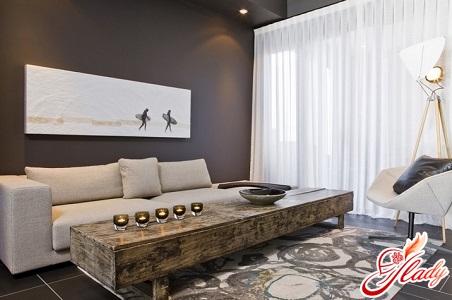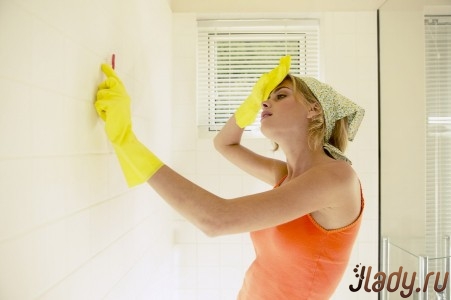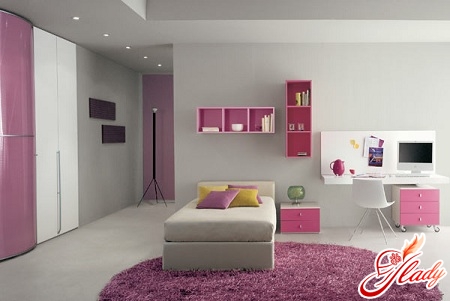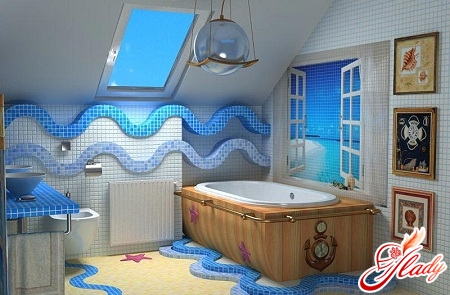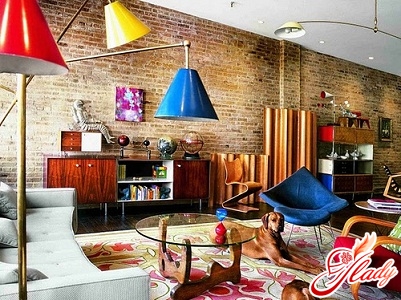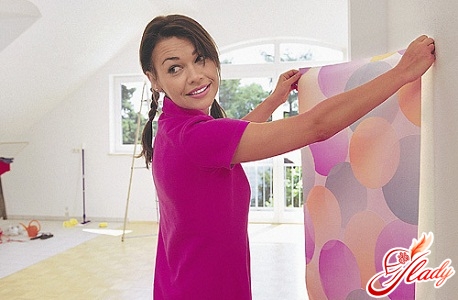 How to properly glue wallpaper? Where to begin? What is necessary? Almost all questions were asked. As soon as the house is in for a grand repair and a catastrophic alarm, we begin to wonder how, what, why. In order to be in all weapons, you need to figure out what you need to glue the wallpaper, what you should pay attention to, and which is absolutely secondary. Wallpapering your own hands is a serious matter. From how you manage to work, will depend on the visual appearance of your room.
How to properly glue wallpaper? Where to begin? What is necessary? Almost all questions were asked. As soon as the house is in for a grand repair and a catastrophic alarm, we begin to wonder how, what, why. In order to be in all weapons, you need to figure out what you need to glue the wallpaper, what you should pay attention to, and which is absolutely secondary. Wallpapering your own hands is a serious matter. From how you manage to work, will depend on the visual appearance of your room.
Rules for gluing wallpaper
The first thing to begin with is to assimilaterules for wallpapering. 1. Preparation of the inventory Tools for gluing the wallpaper, which you may need at any time, should be at your fingertips. This will help avoid tricky situations that can affect the final result. Walling wallpaper on the walls is a laborious process, requiring accuracy. In order for the wallpaper to be glued exactly, stock up a plumb, level, ruler, meter, knife and scissors. Proper wallpapering involves using a wide brush, which will be used to apply glue, sponges, brushes, and, of course, paint buckets. Also you will need various spatulas. 2. Checking How to properly paste wallpaper, the question is certainly important. But no less important is checking your materials. Carefully inspect the rolls, check the color numbers on each of them. Cut the roll is possible only after checking the integrity of the canvas, otherwise, you can not avoid unnecessary expenses. 3.Preparing surfaces Preparing walls for wallpapering is a stage that should not be missed. It should be remembered that all means (putty, etc.) should be selected only on a water basis. Before you buy something in the store, consult with the sellers or find the information on the Internet. As a result of all manipulations, the substrate should be smooth and dry. Preparing the walls for wallpapering begins with removing the old wallpaper layer, if any. When you do this "in a dry", you can tear off some of the plaster, in addition, create a huge amount of dust, which will prevent breathing. Pre-moisten the old layer with warm water and let it get off for 10 minutes. Take an iron brush or a narrow spatula and from top to bottom, clean the wall. When the surface is completely cleaned, it is washed with clean water and checked for cracks. If such are found out, they should be rendered harmless, that is, to cover. The mold or fungus is treated with special means. After these manipulations, the lubricant should dry thoroughly. Please note that the stains left during processing will certainly spoil the look of your new wallpaper. How correctly to glue wallpaper, if it occurs in a room with high humidity? It is simply necessary to additionally primer the surfaces. This will protect your wallpaper from excess moisture. Pasting the wallpaper on the paint, especially on the glue, will require a little different surface preparation. The base should be thoroughly rinsed to wash off the entire surface layer. Moistened in water brush wipe part of the wall area of approximately 2 by 2 meters, after which the paint should get wet. If it was applied in a thin layer, it would be enough to re-treat it with a brush. Thick layers will require more repetitions of the above procedure. Wallpapering on the painted wall, if the paint is pretty strong or completely fresh, is made easier. In this case, remove the layer until plastering is not necessary, just wash the substrate, removing it from dust and possible dirt. How to properly glue the wallpaper in this case? Directly on the wall, just before gluing, apply a sufficient layer of glue. If the paint is kept unimportant, it should be removed without fail, otherwise at one point it will fall off on its own, but along with the wallpaper pasted over it. The strength of latex paint is determined simply: a test piece of wallpaper is glued to the wall by all rules. After a day try to tear this piece off. Insufficiently strong paint will allow you to remove the wallpaper along with the pieces of the base. It can be concluded that wallpapering the wallpaper on the wall without any preliminary preparation is pointless. Wallpapering on old wallpaper is also possible, but in order to avoid various troubles in the form of an unnoticed fungus or mold, the base is better cleaned and carefully prepared. In addition, the applied layer of glue (and this, whatever one may say, moisture) breaks the adhesion between the base and the adhesive layer of the lower wallpaper, they can start to fall off. And one more minus - the paint on old wallpaper under the influence of glue can dissolve, and the stains resulting from this, will pass to a new layer. Wallpapering on the stucco stucco will require special attention, since if the heating is connected, the glue will dry pretty quickly and the wallpaper, not enough to "cling" to the base, may fall away. In this situation, you should either turn off the heating for a while, letting the glue dry, or wait for the warm season. Another recommendation: glaze not only the wallpaper stripes, but also the base, which will promote better adhesion. Options for gluing wallpaper on dry plaster are not diverse. Initially, it is required to fill plaster joints with gypsum mortar (if any) and gauze them with gauze, rinse again and then sand it with sandpaper. The existing nails must be drowned 1 mm deep, the hats are painted, the groove is again shpatlyuyut, dried and polished. Wallpapering on the concrete is undesirable, because when interacting with the adhesive, stains can appear. The gluing of wallpaper on the water-based paint, applied previously to the concrete slabs, will save the situation. And in order to better bond the wallpaper to the base, it is possible to primer a weak adhesive solution with a surface intended for gluing. How to properly glue the wallpaper, if the surface is very smooth (plastic, etc.)? Using a sandpaper, give the necessary surface a certain roughness, so that the wallpaper simply does not slip. The gluing of wallpaper on gypsum cardboard involves training, consisting of several stages. First, the surface must be worked on with an acrylic primer, after which the joints of the sheets should be glued with a construction tape. Secondly, the width of the joints should be puttyped in several layers, and afterwards to process the entire surface. And, thirdly, after the putty is dry, the grinding and priming work is done. Only now your surface will be ready for wallpapering. Wallpapering the whitewash is acceptable, but it all depends on the quality of the whitewash. If it is pretty strong, does not fall off pieces and there are no cracks on its surface, then the wallpaper will hold pretty tightly. Preparing the ceiling for wallpapering will require you to be careful, because any grain of sand, much less a shell, as a result, after gluing will look like dents or bumps. The substrate must be smooth, smooth and dry. The training scheme is exactly the same as the wall preparation scheme. 4.We make glue 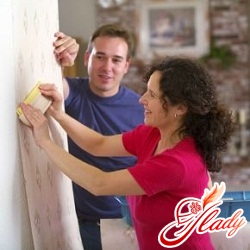 Which adhesive for wallpaper to choose depends on themselveswallpaper. The correctness of your choice influences the final result, it should be taken into account. Which is better wallpaper glue? Of course, special. Before making a choice, let's consider what kinds of specialized wallpaper adhesives exist.
Which adhesive for wallpaper to choose depends on themselveswallpaper. The correctness of your choice influences the final result, it should be taken into account. Which is better wallpaper glue? Of course, special. Before making a choice, let's consider what kinds of specialized wallpaper adhesives exist.
- Wallpaper on a paper basis.
Sticky paper wallpaper requires a careful approach, especially if you choose very thin options. Paper wallpapers exist in several forms:
- simplex - lightweight single-layer paper wallpaper;
- duplex - normal paper wallpaper: washable, corrugated, ceiling, embossed and smooth;
- heavy paper wallpaper - coarse-fiber, structural, foam.
On each roll, they often write, as correctlyglue paper wallpaper and how to plant the necessary glue. A characteristic feature of all such adhesives is their base - modified starch. In addition, the composition includes antifungal components. The gluing of natural wallpaper, which includes wallpaper and paper, allows you to create a unique and unique interior. They can be used for pasting in living rooms. Prepare the glue as follows: pour the powder into cold water, while stirring intensively, leave for 3 minutes and again thoroughly mix. Glue applied to the wallpaper, you need to give time to soak the foundation. Then they will be better attached to the wall.
- Vinyl and non-woven wallpaper
Sticky wallpaper on a non-woven basis most oftenIt is used in residential premises if it is not possible to use more natural materials. The difference between vinyl and non-woven wallpaper is that the vinyls are easy to clean and wash, and at the basis of non-woven fabrics is a fabric that can be repainted more than once. Tapping flezilinovyh wallpaper involves applying the glue not on a roll, but immediately on the wall. The glue contains modified starch, antifungal additives and methylcellulose. After stirring the powder in cold water, it is given 15 minutes to allow it to swell properly, then mix again. How correctly to glue non-woven wallpaper? Directly on the wall, of course, pre-greased with glue. In this case, you will be able to control the joints of the panels. If you ask the question: which wallpaper is easier to glue, then most likely, the answer will be obvious - non-woven. Vinyl wallpapering is done by the same glue, but it should be applied directly to the wallpaper. Do not forget to let the glue soak for 1-2 minutes.
- Universal adhesive
If you decide to combine different wayspasting wallpaper, while picking up more and different types of wallpaper, then the best choice is a universal adhesive. The composition also contains antifungal additives. The basis of the substance is modified starch esters. The proportions of water and mixture depend on the type of wallpaper. Pasting the wallpaper on the ceiling, as in other things and on any other surface, will require a certain amount of glue. The necessary information is contained on each bundle, but there, nor how it is not taken into account, that for the best fastening the surface itself is also missed, where these wallpapers will be "hung". So, it's better to take a couple of packs in reserve. 5.Paskroyka To cut the wallpaper in height, you need to specify the height of your room and add 5-10 centimeters. Already according to the received data it is possible to cut the rolls into strips. Pasting the wallpaper for painting or other single-color options, on which there is no any demanding pattern, will not create difficulties in cutting. All strips will be the same size. Taping the wallpaper butt-end, when it's a direct docking, the strips are identical, and the pattern is combined exactly with each other. And how correctly to glue the wallpaper to the back, if the pattern is shifted? In each following strip, the pattern should be shifted to half the pattern, which is repeated. It turns out that every second strip should be the same. It should be ensured that the roll is unwound all the time in the same direction. How to properly glue vinyl wallpaper, or rather, how to properly cut them? This issue should interest all who are going to buy them. The fact is that this type of wallpaper has an unpleasant property to stretch in a wet form, and an order of magnitude, and after drying - again to take the specified size. Vinyl wallpapering will require patience, otherwise if you do not stick to a certain technique, you risk getting ugly slots between the stripes, rather than a uniformly glued surface. About how and what to do, we'll talk just below. 6.We can glue. In principle, not what glue you use: universal or the one recommended by the wallpaper manufacturer, but how qualitatively this glue is mixed. Regardless, whether the wallpaper is glued to the joint without any additional efforts, or you have to strictly align the pattern, evenly and properly spread the wallpaper with glue, pay enough attention to the edges so that they do not turn out to be dry, otherwise the joints may later diverge. The duration of soaking should be the same. The smeared paper tapes are folded glue inward (proportions 2/3 to 1/3) and gently roll down without any extra effort. So leave the minutes for 10, giving the glue the opportunity to soak the wallpaper base. 7. Adhesive tape 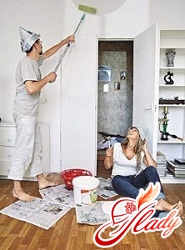 Ways to glue the wallpaper are different, but the conditions inwhich this "measure" must pass through are the same. The optimum temperature of your room should approach 20 degrees. These are the best conditions for gluing wallpaper. Check that out of nowhere skvozilo, and then the wallpaper can swell or fall away altogether. Make marks that will allow the first strip to be strictly vertical. Here you will need the level or plumb line, which we mentioned above. Stitch all the following strips without leaving any cracks. How correctly to paste vinyl wallpaper, remembering about their feature to stretch? The first thing you have to do is to overcome the desire to stretch their edges, regardless of what you were going to do with it: hands or a roller. When stitching the canvas, start, about 1 mm, on the edge. When smoothen all the canvas, gently push apart and overlap butt, then roll them with a platen. In the process, grease the edges with a thin brush, in case of their unacceptable dryness it is not forbidden. Glue wallpaper on the ceiling is best done in a pair, otherwise you risk getting lost in smudged strips and simply transferring the material for nothing. How to glue the ceiling wallpaper? Which direction? The markup should be made from the window to the center, that is, "from the light". When one person pastes them on the ceiling, another uses a squeegee to hold a missed roll that has not yet been pasted. Sticky flizeline wallpaper on the ceiling, in other matters, this applies to any wallpaper, should be carried out in the first place, and only then you can take over the walls. The wallpaper is glued parallel to the wall, which is shorter. For non-professionals - this is a very good option, greatly facilitating the work. Smooth the wallpaper to the ceiling first simply with your hands, and after you take your inventory. How correctly to paste non-woven wallpaper? The first thing that is worth noting: sticking flizilinovyh wallpaper should be done to the back. Secondly, be careful with glue, because, getting to the surface of your wallpaper (especially this is actual in the seams), it is able to change the color of the painted wallpaper, or to prevent the normal painting of the wallpaper intended for painting. Remove it immediately. You can start the gluing of non-woven wallpaper from any angle. Often, move from the window into the interior of the room. Do not forget to pre-measure landmarks. The gluing of wallpaper in the corners, in cases when they are not even, is done in the following way: wallpaper is overlapped, selecting the "by eye" the best option, so that it is aesthetically pleasing. If the wallpaper begins to wrinkle heavily, these creases are cut with a wallpaper knife, and then again leveled. In general, gluing wallpaper in the corners depends on your responsibility. Do not be lazy, and do everything as it should, otherwise the wallpaper may start to move with time. Just do not stick the strip in the "corner" itself or "through the corner". The technique described above for gluing in corners is suitable for all kinds of wallpaper. The gluing of fleselin wallpaper (or any other) with a pronounced texture provides for the use of a bulky roller, instead of a spatula. With this device, we can drive out the excess glue from under the glued wallpaper. Do this towards the edge, which is not yet adjacent to the next strip of wallpaper.
Ways to glue the wallpaper are different, but the conditions inwhich this "measure" must pass through are the same. The optimum temperature of your room should approach 20 degrees. These are the best conditions for gluing wallpaper. Check that out of nowhere skvozilo, and then the wallpaper can swell or fall away altogether. Make marks that will allow the first strip to be strictly vertical. Here you will need the level or plumb line, which we mentioned above. Stitch all the following strips without leaving any cracks. How correctly to paste vinyl wallpaper, remembering about their feature to stretch? The first thing you have to do is to overcome the desire to stretch their edges, regardless of what you were going to do with it: hands or a roller. When stitching the canvas, start, about 1 mm, on the edge. When smoothen all the canvas, gently push apart and overlap butt, then roll them with a platen. In the process, grease the edges with a thin brush, in case of their unacceptable dryness it is not forbidden. Glue wallpaper on the ceiling is best done in a pair, otherwise you risk getting lost in smudged strips and simply transferring the material for nothing. How to glue the ceiling wallpaper? Which direction? The markup should be made from the window to the center, that is, "from the light". When one person pastes them on the ceiling, another uses a squeegee to hold a missed roll that has not yet been pasted. Sticky flizeline wallpaper on the ceiling, in other matters, this applies to any wallpaper, should be carried out in the first place, and only then you can take over the walls. The wallpaper is glued parallel to the wall, which is shorter. For non-professionals - this is a very good option, greatly facilitating the work. Smooth the wallpaper to the ceiling first simply with your hands, and after you take your inventory. How correctly to paste non-woven wallpaper? The first thing that is worth noting: sticking flizilinovyh wallpaper should be done to the back. Secondly, be careful with glue, because, getting to the surface of your wallpaper (especially this is actual in the seams), it is able to change the color of the painted wallpaper, or to prevent the normal painting of the wallpaper intended for painting. Remove it immediately. You can start the gluing of non-woven wallpaper from any angle. Often, move from the window into the interior of the room. Do not forget to pre-measure landmarks. The gluing of wallpaper in the corners, in cases when they are not even, is done in the following way: wallpaper is overlapped, selecting the "by eye" the best option, so that it is aesthetically pleasing. If the wallpaper begins to wrinkle heavily, these creases are cut with a wallpaper knife, and then again leveled. In general, gluing wallpaper in the corners depends on your responsibility. Do not be lazy, and do everything as it should, otherwise the wallpaper may start to move with time. Just do not stick the strip in the "corner" itself or "through the corner". The technique described above for gluing in corners is suitable for all kinds of wallpaper. The gluing of fleselin wallpaper (or any other) with a pronounced texture provides for the use of a bulky roller, instead of a spatula. With this device, we can drive out the excess glue from under the glued wallpaper. Do this towards the edge, which is not yet adjacent to the next strip of wallpaper.
Features of gluing some types of wallpaper
- Cork wallpaper
Such wallpaper is made from naturalmaterials on the market, they are presented in a wide range, which does not make it difficult to make a choice. Each model has its own unique color, texture and pattern. Wax coating applied to the front side allows using them in rooms with high humidity. Corking the cork wallpaper is carried out by the same technology as the gluing of heavy paper wallpaper. But there are a number of its nuances: you can not bend such materials to fracture, because as a result, the crack that has appeared does not lend itself to "fixing". Gluing the corners, do not push the wallpaper into them, and the stitches are glued only to the back. Surplus canvases are cut with scissors, do not use a knife. This is an additional sound insulation, thermal barrier and vibration absorption. Wallpaper has antibacterial properties and does not absorb unpleasant odors.
- Bamboo Wallpaper
Wallpaper bamboo sticker which is possible directlyon a brick or concrete, preliminary preparation thus is completely not obligatory. Just use liquid nails as a "fastener". The procedure is much easier than sticking vinyl wallpaper, for example. If you have a timber, chipboard or fiberboard as the basis, then you can use a furniture stapler or small wallpaper carnations. And if you observe a few more nuances, then your bamboo wallpaper will be very expensive to see. First, where to start the process of gluing, it is with the washing of the surface. Allow the substrate to dry thoroughly. It is not recommended to glue bamboo over fine plaster. In addition, for such wallpaper, water-containing or water-soluble glue is harmful. Use only high-quality vinyl adhesive. The applied glue must be impregnated with wallpaper, this is done to avoid further divergence of joints. When the bamboo wallpaper is already on the wall, do not hurry to press them, let the adhesive mass stay in a plastic state for 5-10 minutes, then gently press them against the wall denser. Excess glue is removed with a soft cloth.
- Textile wallpaper
Sticky textile wallpaper - a noble cause, butand expensive. Chic velor, linen, silk or felt wallpaper will give any room of luxury. Beforehand carefully clean and prepare the wall. Necessarily we ground it with the glue already selected for the wallpaper. How correctly to glue flizilinovye wallpaper, we have already said, but here you can act by the same method: if the basis for flushing, only the wall is missed. If the base paper, then smear the canvas and leave it for 5 minutes to make it soaked, and at this time miss the wall. Smoothing the wallpaper on the wall makes it only vertical movements from top to bottom, no lateral movements. It is better to use a moderately stiff brush. You can only paste wallpaper. If there is no glue on the roll of wallpaper, then we select a special one, designed for fabric wallpaper, and not find one, use vinyl. You do not need to bend the wallpaper, the folds that appear can stay forever.
- Satin wallpaper
Satin refers to heavy vinyl wallpaper. The gluing of satin wallpaper can be difficult, because not all sellers warn that it is necessary to glue the wall with glue as well. In all other respects, the gluing technology does not change. Types of wallpapering depends on the selected material, directly from its features, how they behave under the influence of glue, etc. Pasting wallpaper with a border also requires certain knowledge. You can impose a border directly on the wallpaper only if they do not have a relief deep pattern. Do not forget to pre-make the markup. You can pull the rope and already orientate on it. There is a special curb adhesive that can be purchased at any construction store. With the electricity off, all the boxes from the outlets and switches are removed, the wallpaper is pasted, and only then everything is returned to a decent appearance. Perhaps this is a bit troublesome, but the aesthetic appearance of the room will not suffer. Of course, we did not consider all the details of "oboekleaniya", but tried to emphasize the main thing. Now it's up to little - behind the sticking! Dare and you will succeed! We advise you to read:




